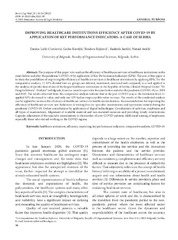Please use this identifier to cite or link to this item:
https://rfos.fon.bg.ac.rs/handle/123456789/2583Full metadata record
| DC Field | Value | Language |
|---|---|---|
| dc.creator | Lečić-Cvetković, Danica | - |
| dc.creator | Kuveljić, Gojko | - |
| dc.creator | Rajković, Teodora | - |
| dc.creator | Janičić, Radmila | - |
| dc.creator | Aničić, Nenad | - |
| dc.date.accessioned | 2023-11-23T07:38:40Z | - |
| dc.date.available | 2023-11-23T07:38:40Z | - |
| dc.date.issued | 2023 | |
| dc.identifier.uri | https://rfos.fon.bg.ac.rs/handle/123456789/2583 | - |
| dc.description.abstract | The purpose of this paper is to analyze the efficiency of healthcare services in healthcare institutions in the years before and after the pandemic COVID-19 by application of Key Performance Indicators (KPIs). The aim of this paper is to show the possibilities of improving the efficiency of healthcare services in healthcare institutions by applying KPIs. For the comparative analysis, 12 KPIs divided into six groups are defined, monitored, measured and compared, as a tool applied to the analysis of specific data of one of the largest healthcare institutions in the Republic of Serbia, Clinical Hospital Center “Dr Dragiša Mišović - Dedinje” in Belgrade, from six-month reports for the years before and after the pandemic COVID-19, i.e. 2019 and 2022. The results observed from the comparative analysis indicate that in the post-COVID year, at the institution level, 11 applied KPIs decreased in value, and only one KPI had an imperceptible value increase. The results of the conducted analysis can be applied to increase the efficiency of healthcare services in healthcare institutions. Recommendations for improving the efficiency of healthcare services are: Reduction of waiting lists for specialist examinations and operations created during the pandemic COVID-19; Online consultations by application of digital technologies; Coordination of activities, employees and all types of examinations; Alignment of available material and non-material resources and providing timely interventions; Capacity adjustment of the specialist examinations to the number of post-COVID patients; Additional training of employees, especially those who started working in the COVID regime. | sr |
| dc.language.iso | en | sr |
| dc.publisher | Romanian Journal of Legal Medicine | sr |
| dc.rights | openAccess | sr |
| dc.source | https://www.rjlm.ro/index.php/arhiv/981 | sr |
| dc.subject | healthcare institutions | sr |
| dc.subject | efficiency | sr |
| dc.subject | improving | sr |
| dc.subject | key performance indicators | sr |
| dc.subject | comparative analysis | sr |
| dc.subject | COVID-19 | sr |
| dc.title | IMPROVING HEALTHCARE INSTITUTIONS EFFICIENCY AFTER COVID-19 BY APPLICATION OF KEY PERFORMANCE INDICATORS: A CASE OF SERBIA | sr |
| dc.type | article | sr |
| dc.rights.license | ARR | sr |
| dc.citation.volume | 31(1) | - |
| dc.identifier.doi | 10.4323/rjlm.2023.50 | - |
| dc.identifier.fulltext | http://prototype2.rcub.bg.ac.rs/bitstream/id/3832/50-58.pdf | |
| dc.identifier.scopus | 2-s2.0-85176583869 | |
| dc.type.version | publishedVersion | sr |
| item.cerifentitytype | Publications | - |
| item.fulltext | With Fulltext | - |
| item.grantfulltext | open | - |
| item.openairetype | article | - |
| item.languageiso639-1 | en | - |
| item.openairecristype | http://purl.org/coar/resource_type/c_18cf | - |
| Appears in Collections: | Radovi istraživača / Researchers’ publications | |
Files in This Item:
| File | Description | Size | Format | |
|---|---|---|---|---|
| 50-58.pdf | https://www.rjlm.ro/index.php/arhiv/981 | 103.4 kB | Adobe PDF |  View/Open |
Items in DSpace are protected by copyright, with all rights reserved, unless otherwise indicated.
